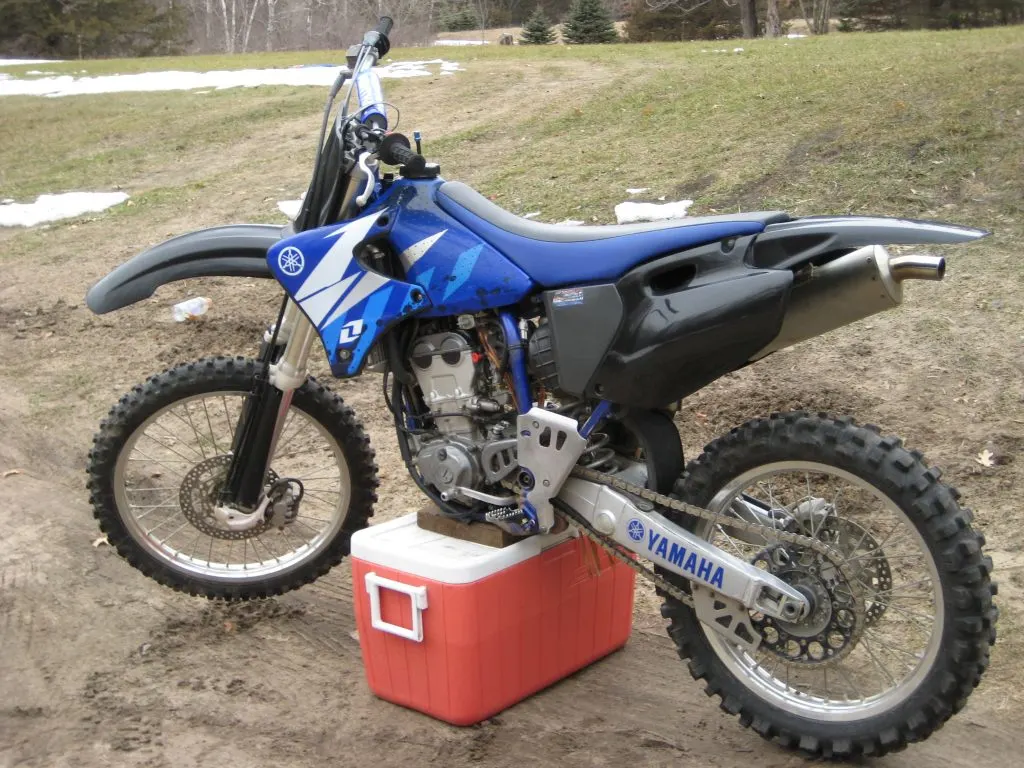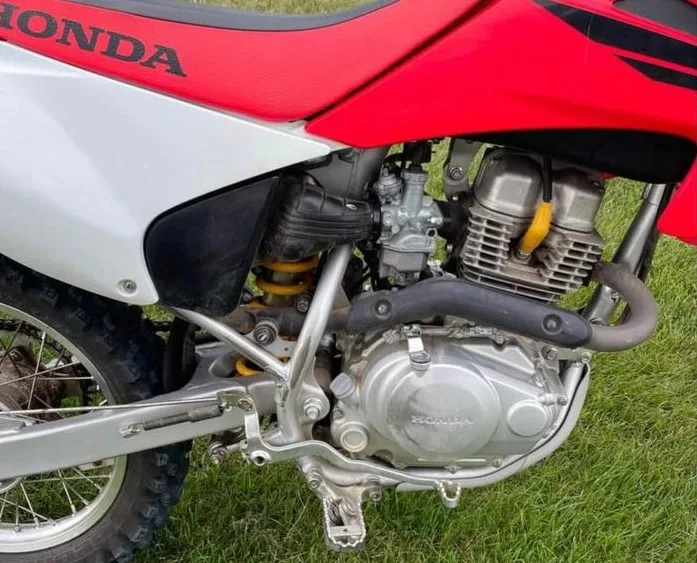Wondering what it means to have your dirt bike knocking? Whether it just started making a weird noise or it’s getting louder, this is the most important article for you!
I’m going to show you what knocking, what it means and what’s causing it, and how to fix and prevent it from happening again.
What is an engine knock sound?
If you’re unsure of what it sounds like, a knocking sound is like taking a ball-peen hammer and hitting a metal bench with it repeatedly. It will usually knock at the same speed/rate as the engine RPM because the engine just keeps spinning around the part that’s knocking.
If the sound continues to get louder, it’s best to stop and check the engine out. For future reference, if your bike is running normally but starts knocking or banging loudly very quickly, shut it off right away! The faster you stop it, the less likely it will take out more parts and cost you more money!

Why is my dirt bike making a knocking noise?
Some dirt bikes are naturally louder than others, so it may sound like something is knocking when it’s actually running as it should be. But, in most cases, a “knocking noise” is generally not good and you should investigate why it’s happening – especially if it just started doing it!
A knocking noise is most commonly caused by a part that’s worn out, making it “loose” or out of clearance, so when it moves or rotates it bangs on another part, which makes the “knocking” sound that you hear.
What causes a knocking sound in a dirt bike engine?
There are many reasons why, and it’s important to learn why there’s a problem so that you can fix the real problem and help prevent it the next time around so that you save lots of time and money.
The most common reasons for your dirt bike knocking are:
- Bad top-end/piston-slap
- A loose cam timing chain
- Faulty cam chain tensioner
- A worn out bottom-end/crankshaft
What is piston slap in a dirt bike engine?
When a piston and/or cylinder get worn out, the clearance between them increases. This allows the piston more room to rock back and forth when it goes up and down in the cylinder. The bigger the clearance, the louder the knocking noises will be.
Worn out crank bearings
The crankshaft has bearings that keep it in place in the crankcase. If these bearings go bad, they can seize your engine.
They go bad from lack of maintenance or high hours on them. They can make a “whirring” or whining sound when they need to be replaced.
What is rod knock on a dirt bike?
Rod knock on a dirt bike is when the connecting rod is so worn out that it’s rocking back and forth on the crankshaft as the piston goes up and down in the cylinder.
The rod is a very tight slip-fit on the crankshaft, so it’s not supposed to have any “slop” or extra clearance as it rotates. When the connecting rod end hole that goes on the crank gets bigger, it will start moving around on it – this causes the dreaded “knocking” sound.
The connecting rod’s big-end bearing surface will stretch or increase in size as it wears out. This will happen exponentially faster if there isn’t proper lubrication and excessive heat.
For example, when you run your engine low on oil (4 stroke engine), there will be much more friction on the rod and crank bearing surfaces. More friction causes more heat, and it will start to “score” the surface and eventually start welding itself together if it gets too hot for too long.
Timing chain tensioner needs adjustment
If your 4 stroke dirt bike is ticking and it has a manual cam chain tensioner, there’s a good chance it needs to be adjusted. When the tensioner gets loose, the cam timing chain flips around and can hit against a cylinder surface and make a loud ticking znoise.
Timing chain tensioner worn out/broken
A worn cam timing chain tensioner won’t be able to keep the chain properly tensioned. This makes a racket of Boise, and it might be loudest when the engine is cold.
This can also happen if you rebuild an engine and reinstall a used tensioner and don’t install it properly. For example, the CRF230F has an automatic cam chain tensioner, and if you don’t wind it up before installing, it will be too much pressure on the internally parts and will be much more likely to break when used again.
What happens if you don’t replace a worn cam timing chain
The cam chain stretches over time, and the more it stretches, the more potential you have for major problems. When the cam chain is loose, that means the camshaft will lag behind because it has to catch up from the chain slack.
This changes the cam timing slightly, and it will continue to change as it gets looser. When it gets stretched so far, the valves will eventually hit the piston because the timing is so far behind from the loose chain. Once a valve hits the piston, the engine is pretty much toast.
2 stroke knocking sound
The most common reasons for your 2 stroke dirt bike making a knocking noise are a worn top-end or worn out crankshaft. This can be caused by normal use and high hours on the engine, but it can also be caused by poor maintenance and user error.
For example, I had a KX125 with a modified engine that required a race gas mix because the cylinder head was modified for more compression. I was riding at a private sand track and it started making a weird noise.
It eventually started sounding like there were a bunch of marbles in my engine and I wasn’t sure what that meant at the time. It lightly seized a few minutes later when starting it again.
I figured out that the race gas mix had gone bad in a matter of a few weeks, causing the engine to detonate and slowly burn down the piston. Fortunately, I was able to send the cylinder out to get replated and fitted for a fresh piston and I was back to riding again.
2 stroke knocking at idle
If your 2 stroke dirt bike engine is knocking at idle, it’s most likely piston-slap. Piston slap is simply a small or worn piston that is rocking as it goes up and down in the cylinder.
This makes it knock and it sounds loud at idle because the exhaust isn’t loud. It’s also the loudest when the engine is cold because that’s when the piston has the most clearance in the cylinder.
As the engine warms up, the metal parts expand and make that gap smaller. This makes the knocking get quieter or go away altogether.
Some Honda’s are somewhat notorious for this due to their loose engine tolerances. It’s always best to check piston to cylinder wall clearance and piston ring gap before installing a top-end. It should be within the minimum and maximum specs stated in your OEM service manual.
How to inspect 2 stroke engine without removing the cylinder or head
You can’t check the clearance of internal engine parts or the bearings without removing the top-end. But you can visually inspect the piston, cylinder, and the bottom end crankshaft to an extent.
To inspect your 2 stroke top-end without removing engine parts, simply remove the expansion chamber (pipe). Then shine a light into the cylinder – you will need to kick over the engine to visually see the condition of the piston and cylinder wall.
Inspecting the piston & cylinder
Obviously, you can’t see the entire piston, nor the cylinder (unless you have a borescope – Amazon), but you can get a good idea. The piston shouldn’t have any scoring/scratches that you can physically feel.
The cylinder shouldn’t have any scoring or gouges, and the cross-hatching should still be there and not have any “wear spots”. The cross-hatching is just the small diagonal lines going up and down.
They’re micro-sized grooves that hold the oil to keep the cylinder lubricated. If the cross-hatch is gone, the cylinder is worn and won’t hold the oil to lubricate properly – a double negative!
Inspecting the bottom end from the outside
You can wiggle the piston side-to-side with the cylinder off to know if the bottom-end crankshaft bearing is good or bad, but can you do it without removing the top-end? A little trick that I learned from Jimmy Lewis is that you can try wiggling/tapping on the piston through the exhaust port with the pipe off.
If there’s a noticeable wiggle, then there’s a good chance you have something loose in the bottom-end. You may not be able to hear it with the engine running, and your bike may even run as well as ever. 2 stroke dirt bikes often run the best right before they’re about to “blow up” or seize.
4 stroke ticking noise
A 4 stroke ticking noise can be caused by a number of things. It’s generally inside the engine and it ticks with the RPM – the faster the engine spins, the faster the ticking noise gets.

Ticking noise in a 4 stroke dirt bike can be caused by:
- Worn cam timing chain
- Cam chain tensioner out of adjustment or worn/broken
- Piston-slap – worn piston and/or cylinder
- Loose valves
- Worn camshaft or rocker
- Something loose in the clutch basket
What to do if you hear ticking
When you start hearing a ticking noise that’s not normal, it’s best to inspect the easy things first. Checking or changing the oil and oil filter are simple and can give you a good idea if there’s already some damage done or not.
When you see lots of metal in the oil and filter, then it’s probably due for a rebuild.
After that, you should check the valve clearances (4 stroke engine) to see if they’re out of tolerance and causing the noise. If they continue to go out of tolerance after repeatedly adjusting them, then it’s most likely due for a valve job.
What is a lean knock?
A lean knock is when the air-fuel mixture is too lean that the fuel is pre-ignition before the spark is supposed to ignite it. This makes a light knocking noise and will eventually burn the top-end down because the lean mixture can’t keep the engine running cool enough.
A lean knock is generally caused by lean jetting or an air leak. It shows up most when you’re accelerating under a heavy load – in sand or riding up a hill.
Why is my dirt bike knocking when I accelerate?
If your dirt bike is knocking when you give it gas, there’s a good chance that something is worn and/or loose in the engine. When you accelerate, the part that is knocking will most likely get louder because it’s banging on another metal part faster and harder.
Pro Tip:
An aluminum skid plate will make engine noises louder because it reverberates/echos the sound. If your skid plate is not mounted solid, it too can actually vibrate and make a loud knocking noise.
How to prevent knocking noises in your dirt bike
While there will always be random cases of dirt bike engines blowing up, many of them can be easily prevented. It just takes a little bit of knowledge, awareness and action on your part.
These are the easiest ways to prevent knocking (or any abnormal) noises in your dirt bike engine:
- Keep enough oil on your engine
- Change oil when it gets dirty
- Keep the air filter clean and sealed properly
- Use fresh gas
- Mix 2 stroke oil at the proper ratio
- Replace parts when they get worn or break
- Follow the OEM service manual when rebuilding your engine
How to prevent a catastrophic engine failure
Worried about having an engine failure while trail riding in the middle of nowhere, or just don’t want a $3000 repair bill? I want to show you the simple steps to prevent that from happening. Click here to learn how.


